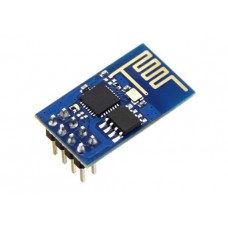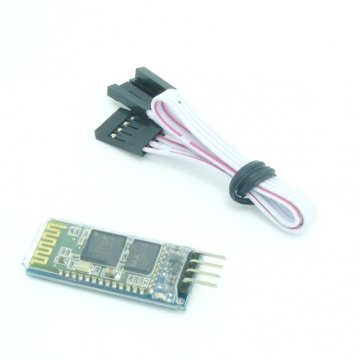- Building a 3D Digital Clock with ArduinoPosted 3 months ago
- Creating a controller for Minecraft with realistic body movements using ArduinoPosted 4 months ago
- Snowflake with ArduinoPosted 4 months ago
- Holographic Christmas TreePosted 5 months ago
- Segstick: Build Your Own Self-Balancing Vehicle in Just 2 Days with ArduinoPosted 5 months ago
- ZSWatch: An Open-Source Smartwatch Project Based on the Zephyr Operating SystemPosted 6 months ago
- What is IoT and which devices to usePosted 6 months ago
- Maker Faire Rome Unveils Thrilling “Padel Smash Future” Pavilion for Sports EnthusiastsPosted 6 months ago
- Make your curtains smartPosted 7 months ago
- Configuring an ESP8266 for Battery PowerPosted 7 months ago
Top 5 Wireless Ways to Communicate with your Controller
One of the strongest trend we have seen this year at CES2015 is, as you can imagine easily, the IoT (Internet of Things) development. Consequently, the most important component needed is the “connection and communication” module that enables the remote interaction between the device and “the community” via internet. Here we will sum up the various possibilities you can use to connect your controller using different wireless protocols.
WiFi
ESP8266 WiFi Module is a WiFi serial transceiver module, based on ESP8266 SoC. This chip implements a full TCP/IP protocol stack and the very interesting feature is that it has also a great computational power onboard. That means that you can use this board as a simple WiFi connection board, offloading the main processor of your controller from the WiFi communication management. Or you can exploit its full power by implementing the logic inside the board itself. Thus you can manage sensors and elaborate autonomously their signals and measurements. Hosting simple applications onboard can let you make a very compact IoT solution.
Here are the specs:
- 32-pin QFN package
- Integrated RF switch, balun, 24dBm PA, DCXO, and PMU
- Integrated RISC processor, on-chip memory and external memory interfaces
- Integrated MAC/baseband processors
- Quality of Service management
- I2S interface for high fidelity audio applications
- On-chip low-dropout linear regulators for all internal supplies
- Proprietary spurious-free clock generation architecture
- Integrated WEP, TKIP, AES, and WAPI engines
- 11 b/g/n
- Wi-Fi Direct (P2P), soft-AP
- Integrated TCP/IP protocol stack
- Integrated TR switch, balun, LNA, power amplifier and matching network
- Integrated PLLs, regulators, DCXO and power management units
- +19.5dBm output power in 802.11b mode
- Power down leakage current of <10uA
- Integrated low power 32-bit CPU could be used as application processor
- SDIO 1.1/2.0, SPI, UART
- STBC, 1×1 MIMO, 2×1 MIMO
- A-MPDU & A-MSDU aggregation & 0.4ms guard interval
- Wake up and transmit packets in < 2ms
- Standby power consumption of < 1.0mW (DTIM3)
There is a dedicated wiki you can read for full specs and, much pleasant, the board is very cheap: check it on our store.
Bluetooth/BLE4.0
Bluetooth is and will be one of the most used wireless protocols in IoT specifications, especially with the recent introduction of Bluetooth Low Energy extension, also known by Apple users as iBeacon. The benefits of BLE protocol became widespread understood when Bluetooth 4.0 release implemented them into the mainstream core. The advantage of this standard is its extremely low power consumption, which helps the making of full battery powered boards with a working time longer than 1 or 2 years in some cases. Another feature, already implemented on many smartphone, is the possibility to embed the management protocol directly at kernel level without requesting any intervention by the users. This facilitates the setup of a mesh network of Bluetooth devices, with lower latency and higher range respect to standard Bluetooth. A detailed comparison between the old and the new release can be found here.
Coming back to our overview, we will sell very soon this board: the Bluetooth V4.0 HM-11 BLE Module.
This is a SMD BLE module based on TI cc2541 chip, very cheap, small and easy to use. The preloaded firmware allows you to quickly build BLE communications via its AT command. Supporting BLE communications with iPhone, iPad (iOS 5.0 or greater) and Android 4.3 or greater.
Specs following:
- Bluetooth Specification V4.0 BLE
- Working frequency: 2.4 GHz ISM band
- Modulation method: GFSK (Gaussian Frequency Shift Keying)
- Transmission power: – DBM, 23-6 DBM, 0 DBM, 6 DBM, can be modified by the AT command
- Uses TI CC2541 chip
- Power supply: DC 3.3V
- Communication protocol: Uart(TTL)
- Default baud: 9600bps
- Transmit current: 15mA
- Receive current: 8.5mA
- Deep sleep current: 600uA
- Operating temperature: -40 ~ 125°C
- Outline dimension: 13.5 x 18.5 x 2.3mm
Another interesting board that has the advantage of being very cheap and a very well-known solution for “Arduiners” is the famous HC-05 Bluetooth module. Googling it, it is very easy to find tons of tutorial on how to connect and configure this board to make it working with Arduino, like at instructables.
Here are a few specs, interesting even if it is an old BT2.0 release board:
- 4G GHz Serial Port Bluetooth Module
- Master/Slave roles
- Bluetooth Specification v2.0+EDR
- Frequency: 2.4GHz ISM band
- Modulation: GFSK(Gaussian Frequency Shift Keying)
- Emission power: =4dBm, Class 2
- Sensitivity: =-84dBm at 0.1% BER
- Speed: Asynchronous: 2.1Mbps(Max) / 160 kbps, Synchronous: 1Mbps/1Mbps
- Security: Authentication and encryption
- Power supply: +3.3VDC 50mA
Zigbee
ZigBee is a specification for a suite of high-level communication protocols used to create personal area networks (WPAN) built from small, low-power digital radios. ZigBee is based on IEEE 802.15.4 standard. Though its low power consumption limits transmission distances to 10–100 meters, ZigBee devices can transmit data over long distances by passing data through a mesh network of intermediate devices to reach more distant ones. ZigBee is typically used in low data rate applications that require long battery life and secure networking (since it is supporting 128 bit encryption): home automation, healthcare, industrial control applications with short range and low bitrate.
Among all the SoC and solutions available on the market, one of the most appreciated and best performing is the Microchip MRF24J40MA, a certified 2.4 GHz IEEE 802.15.4 radio transceiver module. The MRF24J40MA has an integrated PCB antenna, matching circuitry, and supports the ZigBee™, MiWi™ and MiWi P2P protocols. The MRF24J40MA module connects to hundreds of PIC® microcontrollers via a 4-wire SPI interface and is an ideal solution for wireless sensor networks, home automation, building automation, and consumer applications.
Features:
- 2.4GHz IEEE 802.15.4 Transceiver module supports ZigBee™, MiWi™, and MiWi P2P protocols
- FCC (USA), IC (Canade), ETSI (Europe) Certified
- Integrated PCB Antenna with simple four-wire SPI interface to PIC® microcontroller
- Low current consumption (Tx 23mA, Rx 19mA, Sleep 2uA)
- Hardware CSMA-CA Mechanism
- Automatic ACK response
- Hardware security engine (AES-128)
- Automatic packet retransmit capable
- Surface Mountable
More specs here, while on this recent post on Open-Electronics.org we have built a wireless shield for Arduino using MRF24J40MA, check it out!
On our store you can purchase the complete wireless shield FT1150M with the MRF24J40MA module.
GSM/GPS
GSM communication is a must for many remote controlled or remote communication project. Raise the hand who didn’t ever think to make an alarm system with Arduino, maybe for your car or motorbike?
The main problem you faced is how to receive notifications in case of an event, and the best practice would be to receive a SMS. So, the GSM module is what you need for that. Or, if you want to control simple devices, like opening the parking gate or similar, you can use a GSM900 enabled breakout board, like this we sell on Open-Electronics.org.
Here is a collection of the main projects we published on the GSM connected boards, for sure you can find useful advices and suggestions. If you are thinking to use Arduino with this GSM breakout board, you will need a GSM/GPRS shield that, like this one, hosts also the circuitry for GPS, making it a perfect companion when your project needs a precise localization.
Radio RF
If GSM is “too much” for your project, while BLE4.0 or Zigbee features of networking and mesh network topology are not needed for your idea, the last (but not least) alternative you have are RF transceivers. Open-electronics is planning to sell very soon two of the highest rated boards among the Maker community, a 433MHZ solution and a 2.4GHZ solution.
Semtech LoRa SX1278 is a low cost RF front-end transceiver at 433MHZ. It keeps the advantages of RFIC SX1278 but simplifies the circuit design. The high sensitivity (-136dBm) in LoRa modulation and 20dBm high power output makes the module suitable for low range and low data rate applications.
DRF1278F module consists of RFIC SX1278, thin SMD crystal and antenna matching circuit. The antenna port is a standard 50 Ohm impedance. Users don’t need to spend time in RF circuit design and choosing suitable antennas for different applications. DRF1278F operates at 1.8~3.6V with extra low standby current which makes it suitable for battery powered-up applications. DRF1278F is a full-hardware module (no software emulation) and it adopts a ±10ppm quartz, really stable. Users need to read the datasheet of SX1278 carefully in order to use the module at its best performance. DORJI, the module manufacturer, also provides sample codes based on microcontroller and Arduino platform.
This 2.4GHZ board, based on nRF24L01 chip from Nordic, is an incredibly cheap RF solution for ISM (Industrial, Scientific and Medical) applications. It has an antenna integrated on the PCB, quartz oscillator, SPI interface (250 kbps, 1 Mbps e 2 Mbps), transmission distance close to 250m line-of-sight, transmission power +7dB, receiver sensitivity -90dB. Powered from 1,9Vdc to 3,6Vdc, has an I/O level selectable from 0~3,3 V to 5 V, dimensions (mm): 29×15.
Here you can find the nRF24L01 board on Open-Electronics.org.























Pingback: Happy Open Year! Top 10 OpenSource projects | Open Electronics
Pingback: GSM/GPRS connection with web server | Pearltrees
Pingback: How To Communicate With Your Lover | Information